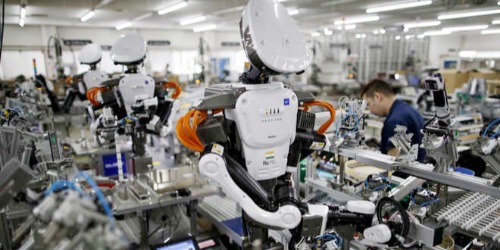Parked cars can hit deadly temperatures in just an hour

Los Angeles :
The inside of a car parked in the Sun can reach temperatures of 46 degrees Celsius in just an hour, and could prove fatal for a child trapped inside, a study has found.
On average, 37 children in the US die each year due to complications of hyperthermia - when the body warms to above 40 degrees Celsius and cannot cool down - after being trapped in overheated, parked cars.
Researchers from University of California San Diego and Arizona State University in the US found that if a car is parked in the sun on a summer day, the interior temperature can reach 46 degrees Celsius and the dashboard may exceed 73 degrees Celsius in approximately one hour - the time it can take for a young child trapped in a car to suffer fatal injuries.
The study, published in the journal 'Temperature', compared how different types of cars warm up on hot days when exposed to different amounts of shade and sunlight over different periods of time.
Researchers also took into account how these temperature differences would affect the body of a hypothetical two-year-old child left in a vehicle on a hot day.
“Young children are vulnerable to the impacts of extreme heat with increased emergency department visits found during heat waves. Internal injuries can begin at temperatures below 104 degrees (40 degrees Celsius),” said Jennifer Vanos, assistant professor at UC San Diego.
“As compared to adults, children have a quicker rise in core temperature and a lower efficiency at cooling,” said Vanos.
Researchers used six vehicles for the study: two identical silver mid-size sedans, two identical silver economy cars and two identical silver minivans.
“We’ve all gone back to our cars on hot days and have been barely able to touch the steering wheel,” said Nancy Selover, research professor at Arizona State University.
“Imagine what that would be like to a child trapped in a car seat on a hot day, either in the sun or shade,” said Selover.
The researchers found that, for vehicles parked in the Sun during a simulated shopping trip, the average temperature inside the vehicles hit 46 degrees Celsius, dashboards 69 degrees Celsius, steering wheels 52 degrees Celsius, and seats 50 degrees Celsius in one hour.
For vehicles parked in the shade, interior car temperatures were closer to 37 degrees Celsius, dash boards averaged 47 degrees Celsius, steering wheels 41 degrees Celsius and seats 40 degrees Celsius after one hour.
“We found that a child trapped in a car under the study’s conditions could reach a body temperature of 40 degrees Celsius in about an hour if a car is parked in the sun, and just under two hours if the car is parked in the shade,” said Vanos.
“This body temperature could be fatal to infants and children - and those who survive may sustain permanent neurological damage,” she said.
The different types of vehicles tested in the study warmed up at different rates, with the economy car warming at the fastest rate and the minivan the slowest due to relative air volumes.
However, when addressing the overall heat gain from temperature, radiation and other factors, a person’s age, weight, existing health problems and other factors, including clothing, will affect how and when heat becomes deadly.
- 5
- Leave a comment
College students in India check smartphones over 150 times a day

New Delhi :
On an average, a college student in India checks his mobile phone over 150 times a day, according to a study conducted by Aligarh Muslim University and the Indian Council of Social Science Research (ICSSR).
The research, titled "Smartphone Dependency, Hedonism and Purchase Behaviour: Implications for Digital India Initiatives", has been conducted in 20 central universities, where 200 students each were interviewed.
"Anxiety and fear of missing out on information make university students check their mobile devices as many as 150 times a day on an average, an activity, which could have adverse effects on the students' health as well as academics.
"Only 26 per cent of the respondents said they use smartphones primarily to make calls. The remaining respondents use smartphones for other purposes such as accessing social networking sites, Google searches and for entertainment such as watching movies," said Mohammed Naved Khan, the Project Director.
At least 14 per cent of the students use smartphones for three hours or less in a day while around 63 per cent of them use it for four to seven hours daily.
"It came as a shock to us that around 23 per cent (of students) use the devices for more than eight hours a day," Khan added.
According to the study, eighty per cent of the students own a mobile phone and most of them prefer smartphones owing to convenience in the installation of applications, host of features, and ease of use and also work as affordable substitutes for a computer.
The study conducted by researchers at AMU has been funded by the ICSSR with an aim to understand various facets of smartphone dependency and addiction among college-going students.
New battery can be charged within seconds

NEW YORK: Scientists have developed a novel self-assembling battery device that can be recharged within seconds and could power mobile devices of the future.
Researchers from Cornell University in the US created a new battery architecture to address the demands for energy storage devices that can be charged faster.
Instead of having the batteries’ anode and cathode on either side of a nonconducting separator, they intertwined the components in a self-assembling, 3D gyroidal structure, with thousands of nanoscale pores filled with the elements necessary for energy storage and delivery.
“This three-dimensional architecture basically eliminates all losses from dead volume in your device,” said Ulrich Wiesner, a professor at Cornell.
“More importantly, shrinking the dimensions of these interpenetrated domains down to the nanoscale, as we did, gives you orders of magnitude higher power density. In other words, you can access the energy in much shorter times than what’s usually done with conventional battery architectures,” said Wiesner.
Due to the dimensions of the battery’s elements being shrunk down to the nanoscale, “by the time you put your cable into the socket, in seconds, perhaps even faster, the battery would be charged,” he said.
The architecture for this concept is based on block copolymer self-assembly, which the Wiesner group has employed for years in other devices, including a gyroidal solar cell and a gyroidal superconductor.
Joerg Werner, lead author of the study published in the journal Energy and Environmental Science, had experimented with self-assembling photonic devices, and wondered if the same principles could be applied to carbon materials for energy storage.
The gyroidal thin films of carbon - the battery’s anode, generated by block copolymer self-assembly - featured thousands of periodic pores on the order of 40 nanometres wide.
These pores were then coated with a 10 nm-thick, electronically insulating but ion-conducting separator through electropolymerisation, which by the very nature of the process produced a pinhole-free separation layer.
Defects like holes in the separator can lead to catastrophic failure giving rise to fires in mobile devices such as cellphones and laptops.
The next step is the addition of the cathode material - in this case, sulphur - in an amount that does not fill the remainder of the pores.
Since sulphur can accept electrons but does not conduct electricity, the final step is backfilling with an electronically conducting polymer - known as PEDOT.
The group is still perfecting the technique, but applied for patent protection on the proof-of-concept work.
Novel robotic system can grow mini human organs

WASHINGTON: Scientists have developed an automated robotic system that can rapidly produce mini human organs required for medical research and drug testing.
The traditional way to grow cells for biomedical research is to culture them as flat, two-dimensional sheets, which are overly simplistic.
In recent years, researchers have been increasingly successful in growing stem cells into more complex, 3D structures called mini-organs or organoids.
These resemble rudimentary organs and in many ways behave similarly. While these properties make organoids ideal for biomedical research, they also pose a challenge for mass production.
The ability to mass produce organoids is the most exciting potential applications of the new robotic technology, according to the developers.
In a study published in the journal Cell Stem Cell, researchers from University of Washington in the US used a robotic system to automate the procedure for growing stem cells into organoids.
Although similar approaches have been successful with adult stem cells, this is the first report of successfully automating the manufacture of organoids from pluripotent stem cells. That cell type is versatile and capable of becoming any type of organ.
In this process, the liquid-handling robots introduced the stem cells into plates that contained as many as 384 miniature wells each, and then coaxed them to turn into kidney organoids over 21 days.
Each little microwell typically contained ten or more organoids, and each plate contained thousands of organoids. With a speed that would have impressed Henry Ford’s car assembly line, the robots could produce many plates in a fraction of the time.
“Ordinarily, just setting up an experiment of this magnitude would take a researcher all day, while the robot can do it in 20 minutes,” said Benjamin Freedman, an assistant professor at UW.
“On top of that, the robot doesn’t get tired and make mistakes. For repetitive, tedious tasks like this, robots do a better job than humans,” he said.
The researchers further trained robots to process and analyse the organoids they produced. They used an automated, cutting-edge technique called single cell RNA sequencing to identify all the different types of cells found in the organoids.
“We established that these organoids do resemble developing kidneys, but also that they contain non-kidney cells that had not previously been characterized in these cultures,” said Jennifer Harder, an assistant professor at the University of Michigan in the US.
“These findings give us a better idea of the nature of these organoids and provide a baseline from which we can make improvements,” Freedman said.
The researchers discovered a way to greatly expand the number of blood vessel cells in their organoids to make them more like real kidneys.
They also used their new technique to search for drugs that could affect disease. In one of these experiments, they produced organoids with mutations that cause polycystic kidney disease, a common, inherited condition that affects one in 600 people worldwide and often leads to kidney failure.
Is MI Redme Note 5 pro is Game Changer Phone for Indian Market




